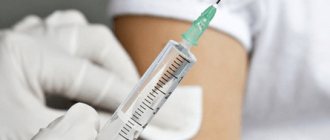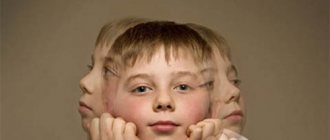Psychogenic disorders
Psychogenic (reactive) disorders are disorders of a neurotic or psychotic level that arise as a result of exposure to shocks that are very significant for a person, negative life situations, and the loss of loved ones.
This is a whole group of disorders, including reactive psychoses, depression, hysterical psychosis, etc. In the International Classification of Diseases ICD 10, psychogenic disorders are included in the heading “Reaction to severe stress and adaptation disorders,” which does not fully reflect the picture of reactive (psychogenic) psychoses.
Causes and factors contributing to the development of psychogenic disorder
The main and, in fact, the only reason for the appearance of a reactive state is the impact of mental trauma, which acts as a trigger. Many troubles happen in a person’s life: natural disasters, wars, man-made accidents, death of loved ones, difficult unforeseen circumstances. It is not always possible to withstand the pressure of negativity that surrounds us. Therefore, many cannot withstand the load, lose self-control, and do inappropriate actions.
A distinctive feature from mental illnesses such as schizophrenia or bipolar disorder is that psychogenic disorders are not associated with heredity. The presence of reactive psychosis in relatives is not the reason for its manifestation in a particular person. In addition, after leaving the psychogenic state, behavioral disorders (adaptation) do not progress; they completely disappear, leaving residual changes in the form of asthenia (exhaustion).
Despite the lack of a clear connection with genetic predisposition, different people react individually to a traumatic situation. This is due to constitutional characteristics, concomitant diseases, duration of exposure to the trigger and the level of mental exhaustion of the person.
Classification of reactive states
Reactive states exist within the framework of neurosis and psychosis. In the first case, the patient remains critical of his condition. During psychosis, a person cannot control himself; he acts destructively and thoughtlessly, often under the influence of hallucinations and delusions.
The following forms of reactive psychoses exist:
- Acute reaction to a stressor (synonym – affective-shock reaction) – reactive psychosis
- Hysterical psychosis - hyperkinetic forms (hysterical excitement - Ganzer psychosis in jailers, during abduction), hypokinetic forms (mutism, stupor, pseudodementia).
- Psychogenic paranoid
- Psychogenic depression
Symptoms of psychogenic disorders
Psychogenic disorders are divided into 3 groups:
Acute psychogenic-traumatic psychoses (reactive)
An acute reaction to stress is a state of shock that occurs under the influence of an extreme situation (natural disaster, exhausting combat operations in war). These include two options: hypokinetic and hyperkinetic.
The classic description of these options belongs to Ernst Kretschmer.
The hypokinetic variant is called psychogenic stupor. Kretschmer called it the “imaginary death reflex.” Why reflex? Because this is the accepted way among animals - this is the norm of reaction. Bug, rabbit, etc. play dead in times of danger. After a sudden massive injury, a person experiences motor numbness with a twilight disturbance of consciousness. This stupor lasts from a couple of hours to 2 days. In most cases, the acute period is not remembered by patients. After leaving the state for 2-3 weeks, a person feels exhausted.
The hyperkinetic variant is called reactive excitation. According to Kretschmer, this is a “motor storm reflex.” Since it is observed normally again in animals. In those conditions when the animal cannot escape, its reflex of chaotic disorderly motor excitation turns on - suddenly a random movement will help it escape and survive. But in humans this is a pathological reaction. There is also increasing anxiety, fear, and chaotic psychomotor agitation. There is no criticism, and such an acute psychotic disorder lasts 15-30 minutes. Afterwards, these people do not remember anything, since they had a twilight state of consciousness.
A striking example is the episode from the film “All Quiet on the Western Front,” where a soldier tried to run out of a dugout during artillery shelling, chaotically waving his arms, and did not understand the speech addressed to him - he began to experience a motor storm reflex.
Hysterical psychosis
In many ways it is similar to an affective-shock reaction. However, consciousness is only partially impaired, and the higher functions of the cerebral cortex are preserved. The main types of reactive hysteria:
- Hysterical narrowing of consciousness . The behavior of patients is demonstrative; they laugh, sing, scream, and “have convulsive seizures.” The person is disoriented, he develops deceptions of perception, and upon exiting the state, he experiences partial amnesia.
- Pseudodementia – the patient experiences imaginary dementia. He cannot carry out basic arithmetic calculations, forgets the names of objects, and performs illogical actions.
- Puerilism is a form of hysterical reaction in which the patient behaves like a child. He calls those around him “aunt” and “uncle,” puts shoes on his hands, crawls on the floor, and speaks with a childish intonation.
Protracted reactive psychoses and neuroses
These include reactive depression and reactive paranoid. These forms have a classical definition given by Karl Jaspers (Jaspers triad).
- Psychosis occurs after and as a result of mental trauma.
- The symptoms of psychosis reflect the content of mental trauma.
- Psychosis ends at the end of mental trauma and depends on the type of personality and the nature of the trauma. A psychosthenic person, for example, will give depression, and an explosive person will give paranoid.
Psychogenic paranoid is a rather rare reactive state that requires either a very high amplitude of the stress factor or prolonged exposure to a trigger situation. A person develops delusional ideas that have a clear connection with this event. For example, wartime paranoia is indicative. A soldier who has survived combat operations cannot get rid of the feeling of insecurity and readiness to strike at any moment. He looks for cover and mistakes people he meets for enemy soldiers. An example of such a state is well described in Remarque’s novel “The Return”. Reactive paranoid is often called according to the typical situation of its occurrence: road paranoid, foreign language environment, prison, etc. Here it is necessary to note another form of reactive paranoid, such as induced. It occurs in the presence of a donor (mentally ill person) and a recipient (located next to the donor).
It is imperative to carry out a differential diagnosis of psychogenic paranoid with a process disease - schizophrenia, where paranoid symptoms are also often observed. With psychogenic paranoid, paranoid (paranoid, systematized) delusions of interpretation are observed. In schizophrenia, the typical delusion is primary (synonymous with paranoid, unsystematized) - delusion of ready-made knowledge.
Psychogenic depression is observed when the patient indicates a clear connection between low mood, depression and a traumatic situation. Depressive symptoms do not always reach a psychotic level, and according to the modern classification of ICD 10, it is then interpreted as “Short-term depressive reaction” and “Prolonged adaptation reaction” (lasts up to two years). In the first case, painful experiences follow immediately after the misfortune. The person feels fear, despair, and has suicidal thoughts. Long-term depression is characterized by a long interval between the trigger and the onset of symptoms. It can reach 6-12 months (no more than 2 years). The patient complains of a feeling of hopelessness, depression, and insomnia. Memories of a traumatic situation are enough to aggravate symptoms.
If depressive symptoms reach a psychotic level, then we observe characteristic manifestations that are observed in severe depression: a significant decrease in self-esteem, ideas of self-abasement (one’s own insignificance) and self-blame (guilt), significant psychomotor retardation, and then normal everyday and social functioning becomes impossible. Exhaustion and dehydration may occur. Delirium, which can occur in the clinical picture, is usually congruent with mood and reflects the content of mental trauma. Suicidal thoughts and even intentions are common, and this can lead to suicide attempts and loss of the patient.
Psychogenic factors can act as the main cause (in reactive states), and also as a provoking or precipitating factor (in endogenous psychoses).
Chronic mental trauma can play the role of a predisposing factor for acute affective reactions, cause neuroses and determine psychopathic development against the background of character accentuations. It is no coincidence that since the establishment of adolescent psychiatry, the leading place in etiology has been given to psychogenic factors.
One of the prominent teenage psychiatrists in England, J. Howells (“Modern perspectives...”, 1971), even proposed dividing all mental illnesses into two groups - mental illnesses and psychoses. If encephalosis is a mental illness due to a pathological process in the brain, then psychoposes are “mental diseases” without brain damage and their essence is a violation of mental functions due to mental stress. Psychoses include neuroses, reactive psychoses, alcoholism, paranoia, drug addiction, and transient situational disorders.
This division seems incorrect. For example, there is a fundamental difference between reactive psychoses and non-psychotic disorders. Reactive psychoses in terms of the level of disturbances are close to other exogenous and even endogenous psychoses. There is reason to believe that in reactive psychoses the functions and chemistry of the brain are significantly impaired, but currently existing research methods cannot detect these disorders. The psychogenic factor in the genesis of alcoholism and especially drug addiction plays a decisive role in their first stages. From the moment of formation of physical dependence, primacy in pathogenesis passes to biological mechanisms.
On the other hand, those diseases that are classified as encephalosis, for example schizophrenia, can be provoked by mental stress and in the initial stages of mild forms do not have any signs of “brain damage”.
Shock factors. In adolescence, shock factors are much less effective than in childhood. Therefore, acute affective-shock reactions are not typical for this age. The resistance of adolescents to severe shocks (disasters, natural disasters, etc.) is not inferior to that of adults, and sometimes even exceeds it. However, following life-threatening attacks on adolescents, they may develop acute reactive states with anxiety, fear, and even persecutory delusions. Sudden and strong fear is a frequent provocateur of attacks in schizoaffective psychoses.
Sub-shock factors. An example of such factors is the loss of loved ones. Sometimes such losses are unexpectedly endured by those around them with amazing resilience. Mental disorders in these cases may be delayed, and an important role in their development is played by new, long-acting psychogenic factors caused by a changed life situation (for example, the appearance of a stepfather shortly after the death of the father, placement in a boarding school after the death of the mother, etc.) . A sudden breakup of a family or a divorce of parents unexpected for a teenager can be much more difficult to bear than the death of one of them.
It is especially difficult to experience sudden emotional rejection from those close people to whom the teenager has great affection.
If a teenager finds out that he is an adopted child and his parents are not his own, then this is always a sub-shock factor, a severe mental trauma, even if it does not cause an immediate obvious reaction.
In post-adolescence, such news is experienced much easier.
Determination of the severity of psychogenic factors. In modern American child and adolescent psychiatry, a classification scheme for stressors (psychogenic factors) according to their severity has been adopted, which is used in multiaxial diagnostics for prognosis purposes. This classification is based on the position that the more severe the stressor that caused a mental disorder, the better the prognosis, since weak stressors can cause it only in the presence of an initial inferiority that complicates subsequent recovery. This position itself is very controversial, since severe stressors can cause consequences that are difficult to correct, an example of which can be post-reactive developments [Felimskaya N.I., 1968 – cit. according to the “Manual of Psychiatry...”, 1983].
In the American classification (“Diagnostic and statistical...”, 1980), mild stressors include the beginning of a new school year, a change in school teacher, and moderate stressors include a change of school, the illness of a close relative, the birth of a sibling, and constant clashes with parents. Divorce of parents, detention of a teenager by police, hospitalization, death of a friend, as well as constant harsh discipline imposed by parents were rated as severe stressors. The death of one parent is defined as an emergency, and the simultaneous death of many family members as a catastrophic stressor. Such a classification suffers from a significant drawback that negates its value for an adolescent psychiatrist—it does not take into account either selective sensitivity to certain psychogenic factors for different types of character accentuation, or individual experience of adaptation to certain psychogenic factors, or the characteristics of living conditions. For example, a change of school for a hyperthymic teenager may not be stressful at all, but only a pleasant and interesting event, and for a sensitive teenager it may not be a moderate, but a very severe mental trauma, more severe than hospitalization, for reasons quite obvious to such a teenager and not reflected in any way. on his reputation. Children of parents who constantly change their place of residence get used to starting almost every school year in a different school, and for someone who has studied in the same class for eight years with the same group of classmates, moving to the ninth grade of a new school can be a big shake-up.
puberty – previous | next – conflicts
Adolescent psychiatry. Content.
Acute mental disorder - treatment
Reactive psychoses require immediate isolation from a traumatic environment and hospitalization. Neurotic spectrum disorders in mild cases are treated on an outpatient basis.
For reactive (psychogenic) paranoid, antipsychotic therapy is preferably not recommended. It is necessary to prescribe sedatives, although they are not etiotropic therapy. It is necessary for the patient to get a good night's sleep.
For psychogenic depression, antidepressants are prescribed if the severity of the depressive state is significant and psychotherapy does not help the patient feel comfortable. For severe anxiety, anxiolytics and tranquilizers are used, and sleeping pills are used to normalize sleep.
The most important place in the treatment of psychogenic disorders is occupied by psychotherapeutic work with the patient at different stages of treatment.
We constantly detect plagiarism on our materials without providing a clickable follow link to them. In this case, without warning, we turn to Google DMCA , which leads to pessimization of the plagiarist. On the contrary, we welcome the popularization of our materials, but with the obligatory active follow link to this page psyhosoma.com/psixogennye-rasstrojstva-reaktivnye-reakcii-cheloveka-na-tyazhelye-zhiznennye-obstoyatelstva/ .
Medical Internet conferences
There are different ways to solve the problem of the relationship between the mental and the somatic. As B.D. believes Karvasarsky and his students (1988, 2006), the formation of symptoms in psychosomatic diseases depends on the following factors:
· unconscious intra- or interpersonal conflict, dissatisfaction of any need;
· personality traits and temperament;
· ways of processing emotions, establishing basic defense mechanisms;
· individual experience, living conditions;
· type and strength of actual psychotrauma.
Probably, both hereditary characteristics and previous diseases play a role in the development of psychosomatosis, especially with long-lasting trace reactions (Burlachuk L.F., Korzhova E.Yu., 1998). Autonomic disorders always participate in the formation and consolidation of psychosomatic disorders (Krylov A.A., Krylova G.S., 1998).
To satisfy any need, a motive (mental image) must arise that can influence behavior. If the motive encounters an obstacle, a negative emotional state (frustration) arises. The situation becomes frustrating, i.e. acquires a psychotraumatic character if a person develops two incompatible tendencies of his own (in this case, the conflict becomes intrapersonal, psychological) [Rotenberg V.S., Arshavsky V.V., 1984].
Currently, the factors that unite various psychological approaches to assessing the significant aspects of neurogenesis and the formation of psychosomatosis are mental trauma, premorbid psychological characteristics of the individual and its basic parameters - temperament and character (Mendelevich V.D., 1999). However, the key point in the genesis of psychosomatic diseases is mental trauma with the subsequent formation of an actual conflict (Topolyansky V.D., Strukovskaya M.V., 1986; Lakosina N.D., Ushakov G.K., 1987; Aleksandrovsky Yu.A., 2005; Alexander F., 1964).
Psychosomatic pathology in its physiological essence is an adaptive mechanism that largely compensates for social maladaptation (Kosenkov N.I., 1997). According to V.D. Topolyansky, M.V. Strukovskaya (1982), 22% of people with psychosomatic complaints occupy up to 50% of a doctor’s working time in the general medical network.
The pathogenicity of the intrapersonal conflict characteristic of psychosomatic diseases lies in the fact that it occurs on an unconscious level, is not realized, and therefore is not controlled (Karvasarsky B.D., 1982; 1990; 2008).
ROLE OF MENTAL TRAUMA
The life of a modern person is full of emotional experiences, and his health is deeply influenced by two completely different sets of environmental factors - the physicochemical and microbiological background and the psychosocial environment (Folkov B., 2007). A decline in the standard of living, breaking of habitual stereotypes, a difficult socio-economic situation in the state - all this forces a person to be in constant mental tension, in a state of stress. The development of psychological stress is also facilitated by interpersonal conflicts, grievances, excessive responsibility, the need to make decisions and strong feelings (Zarakovsky G.M., Medvedev V.I., Kazakov E.K., 2007).
Research by Canadian physiologist Hans Selye (1982), the author of the theory of stress, showed that some of it can even be useful. It mobilizes the body and contributes to a person’s better adaptation to changing conditions. In small doses, G. Selye calls it “a spicy seasoning for the everyday food of life.” But if the stress is very strong and lasts for a long time, then it overloads the body’s adaptive capabilities and leads to psychological and physiological breakdowns. Physiological “breakdowns” manifest themselves in the form of diseases called psychosomatic.
In the scientific literature you can find more than 60 definitions and models of stress. The essence of the doctrine of psychological stress is reflected in the content of its concept. RS Lazarus, R. Launier (1978) defined psychological stress as a reaction to the characteristics of the interaction between the individual and the outside world. This state is largely a product of our cognitive processes, way of thinking and assessment of the situation, knowledge of our own capabilities (resources). According to V.D. Mendelevich (1999), mental trauma (stress) is understood as a life event that affects important aspects of a person’s existence and leads to deep psychological experiences. Stress is a protective reaction of the body in response to an external stimulus, as a result of which the body adapts to changed conditions.
On the other hand, stress is a compensatory adaptive reaction: hormones and biologically active substances enter the bloodstream, which help the body survive a traumatic situation (Aleksandrovsky Yu.A., 2005; Tadevosyan A., 2006).
Many years of research into the mechanisms of development of visceral pathology when a person is exposed to extreme environmental and occupational factors made it possible to formulate the concept of chronic adaptive stress syndrome (Dudarenko S.V., Shulenin S.N., Novitsky A.A. et al., 2007). The phenomenon of incomplete adaptation occurs when it is impossible to adapt to conditions that are extraordinary for a given person, both geoclimatic and microsocial. The state of incomplete adaptation cannot last indefinitely, and if regulatory mechanisms fail, decompensation occurs, manifested by clinical symptoms. Despite the somatic discomfort, the psychological state improves, the disease acquires an independent meaning and is an excuse for non-compliance with conditions both at the level of the body and at the level of the psyche (Chukhrova M.G., Leutin V.P., 2007).
The worldwide increase in the number of mentally traumatized people is becoming a global epidemic. Social upheavals, such as wars, revolutions, ethnic conflicts, and terrorist attacks, affect large groups of the population. Traumatic event, emotional stress, acute and chronic stress, distress, superstress, psychogenic shock, critical event, post-traumatic stress disorder, psychogenia - and this is not a complete list of terms that define the consequences of mental trauma. The mental and organ consequences of these stresses are polymorphic and are known as “psychosocial stress”, causing post-stress disorder (Tadevosyan A., 2006).
Over a relatively short period of time in our country, there has been a collapse of the usual value system, a transition to the standards of a capitalist society with its high motivation for achievement, intensification of the rhythm of life, modification of family values and social affiliation of people (Pogosova G.V., 2004; Pogosova G.V. ., 2007).
Special epidemiological studies using objective methods showed that in the 90s, compared to the 80s, the population of our country experienced an increase in the level of psychosocial stress. It was found that about 70% of the population lived in conditions of chronic psychosocial stress of high and medium levels (Kopina O.S., Suslova S.F., Zaikin E.R., 1996). The emerging trend towards socio-economic growth in the Russian Federation in recent years has not contributed to the stabilization of the psychosocial tension of the population, largely due to the new system of values (Levada Yu., 2005).
According to the results of recent studies, morbidity and mortality from diseases of stress-related etiology in the Russian Federation are growing; there is reason to believe that the process of psychophysiological adaptation of the population to new conditions has not yet ended (Zarakovsky G.M., Medvedev V.I., Kazakova E.K., 2007).
Numerous domestic and foreign studies have shown that psychosocial ill-being and stress correlate with higher levels of prevalence of not only cardiovascular diseases, but also psychogenic disorders, primarily depressive spectrum disorders - depression itself, and associated anxiety, hysteria and neurotic states (Oganov R.G., Olbinskaya L.I., Smulevich A.B. et al., 2004).
A study by domestic scientists has shown that psycho-emotional stress is the main risk factor for the development of arterial hypertension, coronary heart disease, duodenal ulcer, type II diabetes mellitus (Novikova A.I., Sidorov, P.I., Soloviev A.G. , 2007).
Today, the role of psycho-emotional stress and psychological factors in the development and progression of a number of diseases, in particular cardiovascular diseases, among which arterial hypertension is the most common (Kopina O.S., Suslova S.F., Zaikin E.R. , 1996; Gadzhiev A.N., 2004; Pogosova G.V., 2007; Speieker L.E., Hurlimann D., Ruschitzka F. et al., 2002). In addition, the stress factor is an independent risk factor for the development of all diseases of a psychosomatic nature (Novikova I.A., Sidorov P.I., Solovyov A.G., 2007).
Practice has proven that mental stress can cause health disorders of any type:
· disadaptation;
· visceral disorder;
· neurotic manifestation;
· psychiatric symptoms;
· Personality disorders.
The main mechanism for the development of somatization disorders after stress is the mechanism of the stress response itself, which ends at the end organ. The end organ is the organ in which, after its activation, clinical signs of the stress process appear. The end organs include the cardiovascular system, gastrointestinal tract, skin, and respiratory system. Stress indirectly, through nervous and humoral mechanisms, excites those organs and systems whose activation is necessary for the general adaptation syndrome, which implements the “combat alarm” and “battle-flight” reactions. Many researchers and clinicians consider the cardiovascular system to be the main end organ of the stress response. In second place in frequency are the stomach and intestinal tract, which most often react to the emotions of rage and anger (Tadevosyan A., 2006). Currently, the relationship between the factor of prolonged mental stress and the formation of diseases of the gastrointestinal tract has been reliably proven, and the stage of pre-morbid mental and somatic disorders has been identified (Kurpatov V.I., Titova V.V., 2007).
In response to prolonged psychological stress, high personal and reactive anxiety, dissociation of the tropic functions of the hypothalamic-pituitary system, disruption of physiological connections in the hypothalamic-pituitary-thyroid, hypothalamus-pituitary-adrenal system occurs in the body. The criterion for adaptation is the optimal production of key enzymes of the main types of metabolism. The price of adaptation is an increase in energy production, which leads to activation of the free radical lipid oxidation system and the development of “oxidative stress”. The latter is a powerful factor for damage to most organs (Dudarenko S.V., Shulenin S.N., Novitsky A.A. et al., 2007).
It is believed that when a person is exposed to mental trauma (stress), an alternative arises: either due to stress resistance and under the influence of psychological defense methods, the person remains mentally and somatically healthy, or he becomes ill with neurosis or psychosomatic suffering (Mendelevich V.D., 1999 ).
The individual’s reaction to stress or frustration can be, on the one hand, neurotic symptoms, among which psychological and psychopathological manifestations predominate, and on the other, psychosomatic disorders. These groups of disorders demonstrate different ways of processing intrapersonal conflict - mental and somatic. The first method can manifest itself under both acute and chronic stress; the psychosomatic method is more associated with the chronic effects of frustration and stress (Topolyansky V.D., Strukovskaya M.V., 1986; Janca A., Isaac M., Costa e Silva JA, 1995). The influence of chronic stress on the formation of somatovisceral symptoms was noted in the work of L.E. Panin and V.P. Sokolova (1981).
According to some researchers, an alternative also exists within the pathogenetic path: psychosomatic diseases occur in those who, due to personality characteristics, cannot afford a neurotic type of reaction, demonstration of anxiety or fear, fixation on their feelings (Rotenberg V.S., Arshavsky V. V., 1984).
The actual conflict, formed on the basis of mental trauma (stress), according to N. Pezeshkian (1996), consists of life events and microtraumas, the role of which is especially emphasized by this author. The latter include, for example, unpunctuality, uncleanliness, injustice, dishonesty, “infidelity” of a participant in the communicative process. Such microtraumas, acting daily and monotonously, can form an intrapersonal conflict.
A major role in the formation of psychosomatic pathology is played not only by psychological trauma, but also by post-traumatic stress disorder, which occurs as a protracted reaction to a stressful event (Mendelevich V.D., 1997, 1999; Davydov A.T., Keshishev I.A., Zagrebelny I. A. et al., 2007).
The subsequent experience of mental trauma in the form of intrusive memories (reminiscences), nightmares, alienation from other people, loss of interest in life with the formation of endogenous depression and emotional dullness contribute to the emergence of a deep intrapersonal conflict. Such a mental state often provokes abnormal forms of behavior, the desire to distance oneself from reality, to go into the world of fantasies and dreams with the help of drugs and alcohol (Berezin F.B., Miroshnikov M.P., 1996; Mendelevich V.D., 1999).
A person who is in a harmonious relationship with his environment can endure extreme organ and mental stress without pain. However, in life there are personal problems that cause such a painful fixation and mental discord that in certain life situations they lead to the formation of negative emotions and self-doubt. It is in difficult situations that psychosomatically “burdened” patients who exhibit emotional depression cannot correctly assess and describe their condition (Malkina-Pykh I.G., 2003).
Thus, what comes to the fore is not so much the importance or intensity of the psychotraumatic impact, but the repetition, uniformity and duration of microtraumas (Pezeshkian N., 1996). The leading mechanisms of etiopathogenesis of psychosomatic diseases are recognized as psychosocial factors, among which an important role is played by prolonged mental stress, intrapsychic neurotic conflict, as well as acute psychotraumatic situations in combination with the personal characteristics of the subject (Topolyansky V.D., Strukovskaya M.V., 1986; Karvasarsky B. D., 1990; Gindikin V.Ya., 2000).
ROLE OF PERSONAL FACTOR
A significant role in the formation of intrapersonal conflicts belongs to personality types and their individual ability to perceive a wide range of events as frustrating (Dunbar F., 1954). In the Anglo-American literature of different years, personality profiles characteristic of patients with angina pectoris, hypertension, bronchial asthma, etc. were described. The overall result of these studies was, rather, the denial of personality structures characteristic of individual diseases. More precisely, we should talk about the personality characteristics of a psychosomatic patient in general, considering as a basic characteristic the presence of an infantile personality structure, a neurotic life position, since the somatic expression of emotional experiences is an infantile form of their expression (Karvasarsky B.D., 2002).
Individuals with different personality types have different features of the regulation of autonomic functions, ensuring the effectiveness of adaptive reactions and, as a consequence, different levels and reserves of health (Soldatova O.G., Savchenkov Yu.I., Shilov S.N., 2007).
In the work of N.I. Kosenkova (1997) showed that patients suffering from peptic ulcer of the gastrointestinal tract and neurocirculatory dystonia experience a slight decrease in intelligence, an increase in paranoid personality traits, as well as activation of inhibitory processes and depletion of excitation processes in the central nervous system, especially in the right hemisphere. At the same time, with insufficiency of the right hemisphere, the resulting emotional disorders are to a greater extent combined with viscero-vegetative disorders (Krishtal V.V., 2001). In the structure of “adjustment disorders” in psychosomatic patients, anxiety and a high level of hypochondria were observed (Davydov A.T., Keshishev I.A., Zagrebelny I.A. et al., 2007).
According to some researchers, patients with psychosomatic diseases and neuroses have a common personality trait - high emotiveness, which determines sensitivity to traumatic influences. At the same time, psychosomatic patients have low dysthymia, suggesting the presence of a sufficient adaptation mechanism to overcome affective tension of the anxiety-depressive spectrum (Atamanov A.A., Buikov V.A., 2000).
Patients with psychosomatic pathology are characterized by a wide range of fixed forms of behavior - obsession, adherence to stereotypes, stubbornness, pedantry, which indicates a high degree of rejection of the demands of objective reality (Kosenkov N.I., 1997). “Personal systems”, regulations and self-restraints appear, aimed at cutting off everything unnecessary that interferes with maintaining a “social face” (Atamanov A.A., Buikov V.A., 2000).
The role of the personality factor in the development of dysfunctions is also consistent with psychological indicators, reflecting a tendency to increase the level of anxiety and decrease the level of aggressiveness (Soukiassian S., Manassian A., 1999).
In patients with psychosomatic pathology, neuroticism and introversion become more important, which indicates a state of reactive anxiety or reactive depression, leading to inappropriately strong emotional reactions in relation to the situations that cause them (Kosenkov N.I., 1997).
ROLE OF ANXIETY AND DEPRESSIVE DISORDERS
Psychosomatic disorder is a way of “compensating” for pathological changes in the biological matrix of the emotions of anxiety, manifested by mental, autonomic and organ disorders (Anokhin P.K., 1980). Anxiety, as one of the most intimate and obligate mechanisms of mental stress, has important adaptive significance (Berezin F.B., 1988). The emotional reaction, expressed in the form of melancholy and constant anxiety, as well as a characteristic feeling of fear, is a connecting link between the psychological and visceral spheres. The state of anxiety is the leading pathogenetic factor in psychosomatic pathology. Moreover, in the remission phase of the disease, the state of anxiety is more pronounced, and at the time of exacerbation - weaker (Kosenkov N.I., 1997).
Particular attention in the mechanisms of formation of intrapersonal conflicts is given to increased personal anxiety as the most stable personality characteristic, increased neuroticism and depression (Mendelevich V.D., 1999).
Typical symptoms of an anxiety state are a feeling of constant restlessness, nervousness, irritability, and intolerance to common everyday irritants. However, patients with anxiety disorders come to see a doctor not with the complaints listed above, but with a mass of organ complaints. Anxiety disorder almost always includes adaptive autonomic symptoms caused by activation of the sympathetic nervous system and increased free radical oxidation of lipids. Typical vegetative symptoms include palpitations, “interruptions” in the activity of the heart, cardialgia, unstable blood pressure levels, feelings of heat or chills, shortness of breath, a feeling of “lump in the throat”, tremors, headache and dizziness, muscle twitching, paresthesia, unstable stool and etc. But despite the abundance of complaints, even with the most thorough clinical and instrumental examination, some patients cannot be diagnosed with any serious disease (Pogosova G.V., 2004).
Reducing anxiety due to adaptive reactions (use of psychological defense mechanisms) is accompanied by a decrease in the activity of lipid peroxidation against the background of increased antioxidant defense functions (Mikhelson V.A. et al., 1988; Mankov Yu.U., Krashutsky V.V., 1989) .
It is believed that anxiety disorders increase the risk of later developing depression. At the same time, anxiety and depression can be either comorbid mental disorders or be within the same diagnostic category - “mixed anxiety-depressive disorder” according to ICD-10. The combination of these symptom complexes is the rule rather than the exception, which is confirmed by the presence of a strong correlation between them (Kovalev Yu.V., 2004; Vanchakova N.P., 2007).
According to A.A. Atamanov and V.A. Buikova (2000), anxiety disorder in psychosomatic patients has its own clinical characteristics. The most striking and complex manifestations of anxiety in such patients are the autonomic, motor and senestopathic components. The cognitive component of anxiety (the conscious experience of anxiety and ways to deal with it) is weak or absent. Anxious affect is significantly simplified, which is manifested by the suppression of anxious impulses to act, speak, and affective release through laughter, crying, and anger. It has been suggested that the symptoms of anxiety disorder are specific in various psychosomatic diseases.
In general, the validity of the term “psychosomatic anxiety”, its meaning and content require further clarification. Clinical identification of elements of the psychosomatic anxiety symptom complex, issues of typology and systematics, pathogenesis and therapy remain the subject of scientific discussion and deserve close attention and study (Atamanov A.A., Buikov V.A., 2000).
The problem of psychosomatic relationships remains one of the most complex problems of modern medicine, despite the fact that the close relationship between the mental, somatic and organ components has been noticed and studied for many centuries, since the times of Hippocrates and Aristotle.









